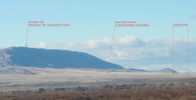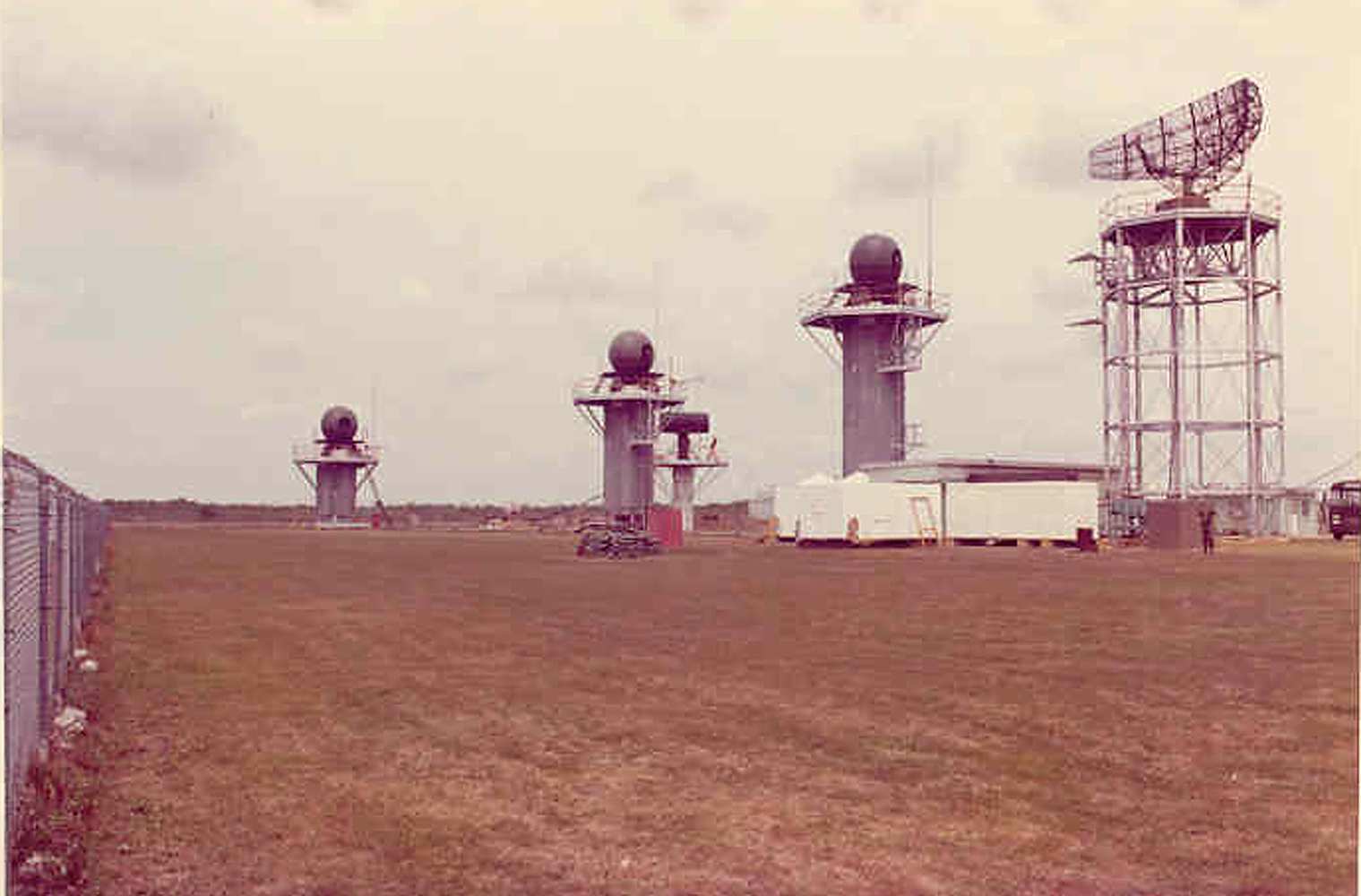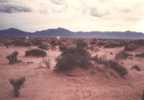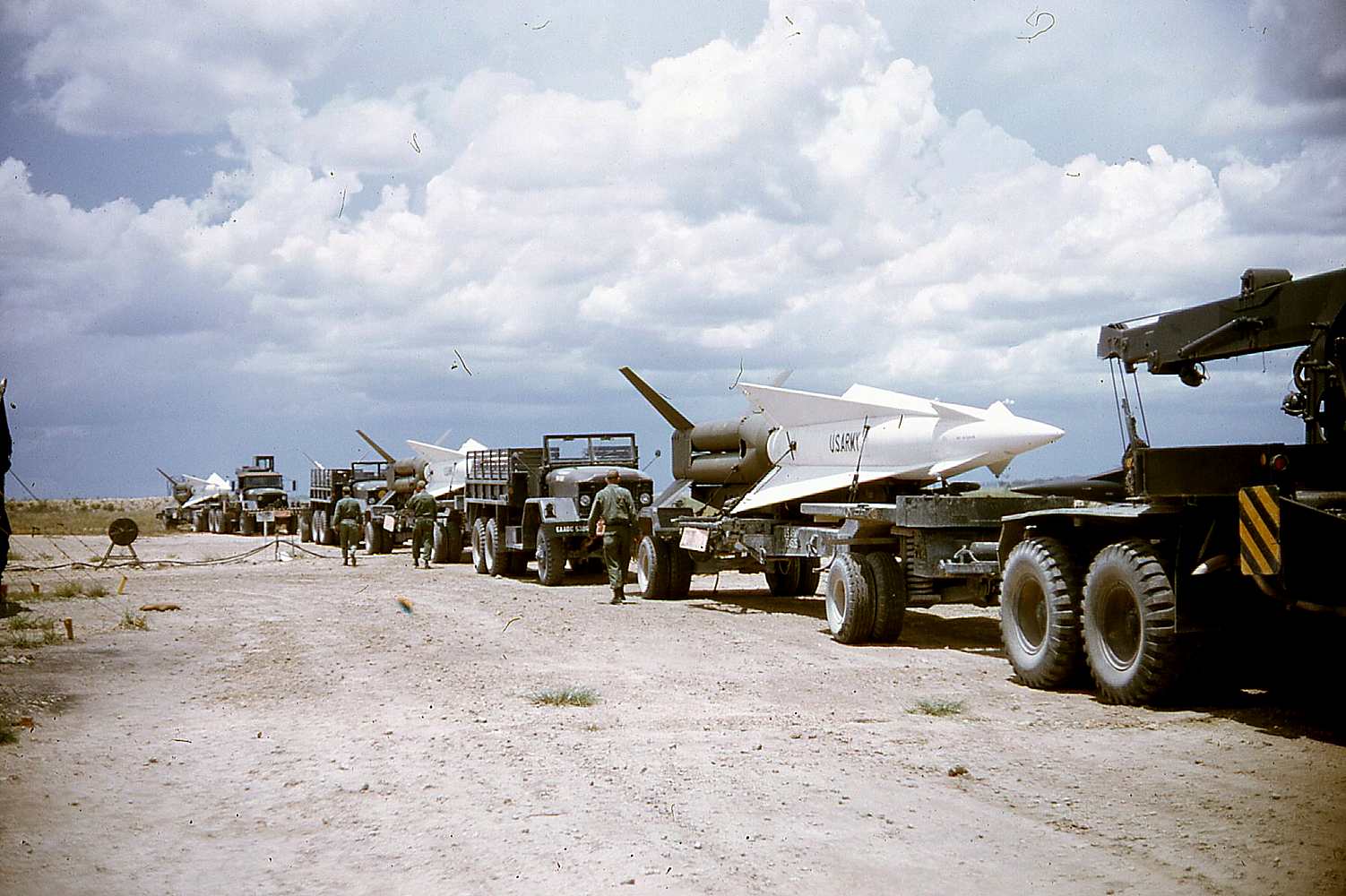Return to Home,
Goto Next Section
Contents:
- Beginning of Air Defense of the United States
- Nike was part of a coordinated anti-aircraft defense
- Nike was designed to be mobile but most were in fixed sites.
- Location - Where do you find Nike installations (sites)?
- Outside Support Requirements
- Land Procurement
- Site Construction
- People
- Nike Ajax Site Layout , pictures of PI-37
- Why separate radar and launcher areas?
- Connection between the radar and launcher areas?
- Some Nike Ajax sites upgraded to Hercules
- Nike Hercules Site Layout
- 1963 - Peak of Nike Deployment - and the end in 1974
- Nike configurations 'world wide'
- Nike was 'mobile'?
- Was Nike a 'good' system?
- Security - Physical and Communications
- Connection between the radar and launcher areas?
Link to Introduction to the Improved Nike Herculese Missile System - 1.0 megabytes - .pdf format
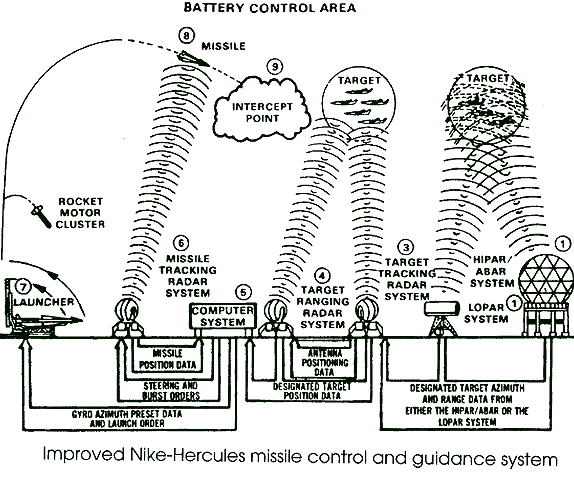
From FM 44-1-2 ADA Reference Handbook, 15 June 1984,
see page 21 "Rings of Supersonic Steel"
Beginning of Air Defense of the United States
The following section was highly condensed from the 40 page article Vigilant and Invincible by Col. Stephen P. Moeller, "ADA" magazine, dated May-June 1995. The parts selected were relative to the beginnings of the Nike program, the article is much more complete. Magazine correspondence address is ADA magazine, USAADASCH; ATTN: ATSA-ADA, Bldg. 2E, Fort Bliss, TX 79916-3802. Telephone (915)568-4133."... The Korean War provided the impetus that got the air defense program rolling on many levels and in many areas. ... When the Chinese entered the war, direct confrontation between superpowers ensued. America now girded itself for a possible attack on its homeland. ... ARAACOM was formed within a week. ... Even before ARAACOM was born in 1950, batteries of 120mm guns had deployed to protect the plutonium production plant at Hanford, Wash. ... The ARAACOM staff moved into the basement of the Antlers Hotel, where they remained for several years before moving to Ent. ... ARAACOM's mission was to train and deploy antiaircraft forces in defense of critical areas of the country. The listing of critical areas would be massaged and changed over the years, but the initial list included industrial centers, the national capital region, SAC bases, Atomic Energy Commission sites, and other key areas such as the narrows and locks at Sault Sainte Marie, naval bases at Norfolk and Philadelphia, and the electric power production facilities at Niagara Falls."There were many more assets to be defended than there were forces to defend them . ...
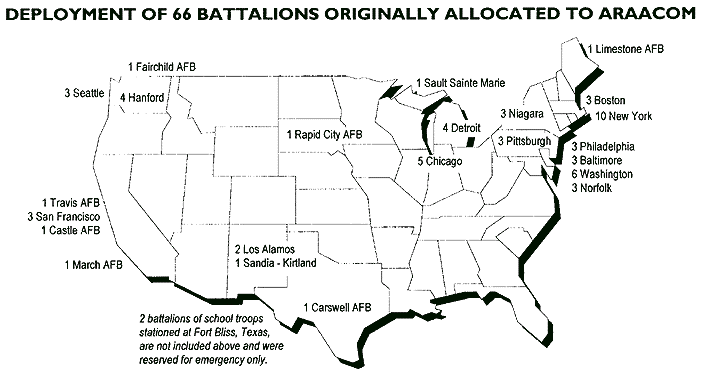
"... ARAACOM soldiers operated a mixture of old and new gun systems. The old part was the century-old rifled cannon technology that hurled projectiles at the enemy, and the new was a radar-controlled, computerized, integrated fire control system that pointed the guns. ..."... In early 1951, the director of guided missiles informed the secretary of defense that immediate acceleration of production processes for the Nike-I Project was considered necessary to get the missile system out of research and development and into the tactical weapon state at the earliest practicable date. ...
"... To train soldiers to operate and maintain this new generation of antiaircraft technology, the Army established a guided missile department at the Antiaircraft School, Fort Bliss, Texas, just south of where the Nike testing was taking place in New Mexico. ...
"... Selection of sites and land acquisition were major problems. Maximum use was being made public lands, even though using such sites often violated tactical considerations and resulted in less than optimum defense. By far the greatest number of battery sites had to be located on privately-owned land and, in most instances, high real estate costs and adverse reaction by owners made the acquisition problems acute. ... "
Nike was part of a coordinated anti-aircraft defense
NORAD--the joint U.S.-Canadian North American Air Defense Command -- had responsibility for air defense of the United States and Canada. For further information on NORAD see "US Army Air Defense Digest, 1966". Major components of the NORAD included:
- Early warning ground based and aircraft based radar systems
This included the Distant Early Warning and Mid-Canada radar lines, "barrier forces" comprising picket ships, Air Force and Navy radar aircraft patrols, and "Texas tower" radar stations.- Area or regional headquarters for coordinating defense activities. SAGE (Semi-Automatic Ground Environment), an Air Force sector-level command and control system.
- Fighter aircraft and Bomarc missiles were to down most enemy aircraft, and to disrupt the attack. The Bomarc missile was ramjet powered guided missile with a range of 400 miles at Mach 2.5, operated by the Canadian and American air forces. It had a nuclear warhead.
- Local area surveillance radar - aid vectoring the fighters, assign targets
- Nike surface to air missile systems - down all remaining aircraft still attacking
The Air Force was responsible for "Area Defense", and the Army (ARADCOM) was responsible for "Point Defense". The Air Force, with its mission of "Area Defense", was responsible for providing "Area Defense" information to the Army Nike systems. A discussion of the Air Force role is provided here.
A system of some 22 SAGE computer systems was deployed in the late 1950s to help combine inputs from radar, observers, etc. and help organize defensive operations. A SAGE Movie - if you have the Internet bandwidth
Personal Experience in early Nike program by Ed Thelen
In the early deployment of the Nike sites (1955-1956), there seemed to be little inter-site, inter-area, or inter-service coordination. I am told that as time went on, reliable land lines and radios linked the sites with area controls, and that combined Army & Air Force exercises were performed, and that the Air Force tried out its jamming equipment against the Nike sites. There were several system developed later that provided quite automatic target assignments from headquarters (rather than calling target assignments by grid co-ordinates over the phone). There was a training system developed later (called "T-1") that could simulate jamming, incoming targets, and could give the operators valuable experience and a good workout. I saw none of that in the first two years in Chicago. Half of the time we could not contact the Air Force area control "ELKO" near Elkhorn, Wisconsin (and when we could, the bored voice on the Air Force end really did not care).
My first year, if you wanted to talk with an adjacent battery, you called the orderly room and got a connection through the commercial telephone system. (There was a radio supplied (with out manuals) for inter-battery communications, but none of the Nike sites could get them to work.) We often got our alert status by a phone call via the commercial phone system.
We never saw any form of jamming. The only things we knew about jamming were items from the newspapers and radar books from the public library. If course we electronic types could imagine jamming equipment and techniques that could be employed against us - and it turned out we guessed about 60 percent of the techniques I have heard about years later! Interesting? - it made me nervous!
From Chris McWilliams
Saw your remarks to ... about plotting tracks. That's what we did in USAF AC&W (radar) Squadrons. Tracks were plotted writing backwards on a large edge-lighted Plexiglas screen while standing on "bleachers" (scaffolding behind board to allow us to reach top of board). Plotter was part of our job, which included scope dope, height finder, teller (pass info to adjacent sites and HQ), security (man guard shack), radio alert (listen to many receivers for aircraft calling site), usually rotated through with about an hour on each. During missions or alerts, the best people on each activity would usually stay on that job until conclusion of the mission.
Location - Where do you find Nike installations (sites)?
Each Nike site was a major investment in equipment (in the 10's of millions of 1960 dollars) and people (about 130 per site was authorized in the TO&E - Table of Organization and Equipment - ). As the demands of the Vietnam War increased, fewer troops were assigned to each Nike battery - 80 people and very long hours were common.Since they are one of the nation's anti-aircraft systems (fighter type aircraft being another major, and expensive weapon) they are found in places deemed important to defend, such as major cities (and major Air Force offensive and defensive installations).
Nike sites were placed around (surrounded) large targets, like large cities because:
- the effective range of Nike is less than 100 miles, and they must stop aircraft about 30 miles out,
- a defense needs some depth,
- enemy aircraft would be expected to prefer to approach along undefended routes.
H-52 Rattlesnake MountainSome Nike sites defended a more lonesome place such as a SAC base - and four defended our atomic facility at Hanford Reservation, Washington. These fellows were not in easy reach of Pizza Delivery or any of the other advantages of civilization. The sender of this H-52 Rattlesnake Mountain picture, Dean Jonasen wrote "It was way out in the desert... Hot in the summer, and damn cold in the winter. When the orderly room started asking for volunteers to go to Germany I LEAPED at the chance."

Booster Drop Zone
Alaska, from James BilesA very touchy point about where to put a site was the missile booster drop zone. A Nike missile was started on its way by a rocket booster. This booster would land about 1 mile from the launching site and would kill anything with in about 3 feet of where it landed. Outside of that zone, you would get a BIG surprise, but probably be physically unharmed. This caused much worry with people who were otherwise happy to drive drunk (or with the drunks) on the public roadways where 50,000 per year were being killed. (MADD "Mothers Against Drunk Driving" ) is a rather recent development.) So a large un-inhabited drop zone was a political requirement for each Nike site. (Even though people were assured that Nikes would not be fired from the city sites for practice.) Radars as high as practical
From NIKE AJAX - HISTORICAL MONOGRAPH - why underground magazines?
As originally designed, the equipment of the NIKE battery was located above ground in two separate areas: the battery control area and the launching area. Based on Ordnance safety regulations governing the surface storage of explosives, it was determined that a NIKE site would require about 119 acres. Such a large amount of real estate would be both costly and scarce, particularly if the site should be located in some metropolitan section such se Brooklyn, New York. The only feasible solution to the real estate reduction problem came from the OCO Safety Office, which suggested that an underground launcher installation be used. This would reduce the real estate requirement for individual installations to about 40 acres; since the battery would become a magazine. But there were yet two questions to be answered: Would it be feasible to modify the present launching equipment; and if so, would the Army Antiaircraft Command (ARAACOM) be willing to accept such a fixed installation in lieu of the mobile system originally specified.
Outside Support Requirements
During normal daily operations, Nike sites used commercial electrical
supplies where they were available. ...
The generators included in battery equipment
were used for standby and emergency power. They were run under full load at
intervals to ensure readiness in the event that commercial supplies were
disrupted.
Water supplies for most batteries were obtained from municipal sources. For
more remote sites, wells were used. In one instance well water was
reportedly used for non-potable uses, and drinking water was trucked to the
site. If municipal sewers were available, they were used to dispose of
wastewater. Where such service was not available, septic tanks, oxidation
ponds, or package treatment plants were used.
Solid waste generated at Nike facilities was disposed of through a variety
of means. Often, the unit would have an agreement with a municipality for
use of the public landfill. Very few of the Nike sites included as
operational landfill.
...
Buildings at most sites were heated by small oil-burning boilers. The fuel
for these boilers was a major part of the petroleum, oils, and lubricants
(POL) stored onsite. Reportedly, same sites in Alaska used turbine-type
space heaters fueled with JP-4 in place of the oil-fired unite.
He
was in the CIC back in the mid-late 50s. Since he was
the guy in the office with a TS clearance and knew the
area, he drove a bunch of Army guys around looking for
a good site north of St. Louis.
As far as most of us Army people were concerned,
the sites and concrete were there, we just moved in.
Being a bit of a farmer, I was always curious about the
reactions and interactions between the farmer (mostly)
and the usually city slicker procurement people.
I had heard one story similar to this -
Later ultimate city slickers arrive wanting the top of a hill, with rights to put a road,
and power, and water, and general trespass to the top of that hill.
The city slickers talk about defending America,
freedom and property rights - then say
The farmer weights his options,
talks with an attorney,
and agrees to chop up his farm
for the city slickers.
"Pete"of St. Louis wrote back
Ah - yes - and the Nike sites along the Chicago water front (I was at C-41) were Chicago park property.
And out here in the San Francisco area, the high outlying points all seem to be parks also. And even Angel Island
in the bay. Interesting - maybe there were fewer farmers involved than I worried about. And selling off flat land
in Texas, Minnesota, ... might not be such a big deal?
Dispersal, after the Nike program was over
Plante, Ron sent a
document about Nike land near SAC bases - 750 KBytes
However, I have no direct knowledge of site construction. When we early birds arrived at
C-41 in Chicago, we "helped" the crane operator put the radars on the already existing pads,
and helped the crane operator lift the vans, we removed the wheel assemblies, and the vans were lowered
onto existing pads.
Soon we had the in-area cables laid and things running, but needed the interarea cable laid to the Launcher area.
A contractor dug a trench through Jackson Park. There were complexities of permitting/securing the cable
through an existing walkway under
the Chicago "Outer Drive".
James Newman
In box 23 I came across several folders of the construction progress of the Nike Site NY-29/30 Lido Beach NY.
I also came across over 500+ pages of the contract dispute correspondences between the NY Army Corps of Engineers and the
prime contractor Peter Reiss Construction Co and their sub contractor Bern Construction Co. covering the years 1955 to 1962.
From what I am able to put together is this on the history of the construction of the site:
In 1954 the Contractor WD Johnson ( I believe this is the name of the contractor
I do not have the paperwork in front of me) was awarded a contract to do soil borings and clear the land and dig the foundations
for several buildings in the launcher area. The contract ended in September 1955. The initial soil borings in May 1954 gave the water table
as 7 feet below ground. The Army Corps of Engineers went with this information and drew up plans for the below
ground magazines and the water and sewer lines.
Construction was started shortly thereafter in June 1954. The Prime contractor hired
Bern Construction Co. to build the water and sewer lines on site. Ditches were dug for the clay pipes and they encountered
water at 4 feet. (IE the water table rose). At the end of August 1954 Hurricane Carol struck the NYC area and delayed construction at
least 1 month to 2 months according to the correspondences in late 1954. Two weeks later Hurricane Edna struck. These two
Hurricanes rose the water table to two feet. Pumps were brought in to keep the ditches pumped out so they could continue.
Hurricane Hazel in October while not near NYC did cause some rain in the area and delayed construction for a week.
In July 1955 the Peter Reiss Consrtruction Co won a $844,000 contract for the Lido Beach Nike site. They took over the construction of the site and built the rest of the buildings. They also hired the Bern Construction Co as a subcontractor. In March 1955 soil borings were also taken again at the launcher site for the Type B and C magazines. The water table was 4' 9" deep. The foundations for the magazines were dug and they encountered water at 3 feet. Pumps were brought in and construction continued. In January 1956 two sump pumps were installed in the Type C magazines each. The pumps ended up failing as water and fine grain silt got in to the pumps. The NY Army Corps of Engineers asked the prime contractor to replace the pumps which they did dutifully and claimed an additional $900 for the replacement of the pumps. (Claim 1)
In June 1956 the pumps again failed and the Prime contractor had to replace the pumps again and dig up the concrete of the magazines to replace them and a portion of the piping. This time they claimed about $2500 in compensation. (Claim 2). The site was accepted in September 1957. The pumps continued to fail after this in 1958 and additional portable pumps were brought in to keep the magazines pumped out. The subcontractor Bern Construction Co. was called in several times a week to pump out the magazines (according to the correspondences from Bern to Peter Reiss.) The Bern construction company claimed 1,180 hours of pumping contract time in 1958 and 1959. and billed the Peter Reiss Co for nearly $14,500. The Peter Reiss claimed that number under the prime contract and submitted a claim for pumping services and overtime pay. (Claim 3)
Well come to find out that the Bern Construction Co. didn't keep good time cards records and the Commanding Officer of the site (C/3/51) testified that the Bern Personnel were only on the site doing pumping work of 180 hours. The rest of the time it was the site personnel doing the pumping out of the magazines. All three claims were denied by the Army from Peter Reiss as being without merit even under double appeal. This ended up dragging into September 1962 in Federal court. The court in 1962 wanted to recall the CO of the site from 1957 but could not find his address for testimony (it was believed he ended up in Vietnam at this time)
I am willing to scan the photocopies of the Lido Beach Nike site construction photos as a PDF if you are interested.
Cory Newman
Total (nominal if 2 launch sections)
The Nike battery commander was usually a captain. He controlled the
battery both administratively and tactically.
His "staff" included:
And about 90 "other ranks" (as the British so politely put it).
(I am advised that later in the Nike program, sites got extremely short handed
and had about 80 people.)
A statement of Nike site manning is actually surprisingly complex.
For a much longer discussion see
Nike Manning Requirements
(The current PATRIOT missile system has much smaller physically,
requires much less maintenance, and requires many fewer people to fire the battery.)
Here are pictures of PI-37, a "typical" Ajax site, but with an added ABAR radar.
Only one elevator is shown in the above diagram.
Where people were not so close and/or land was less expensive, such as near
SAC (Stratigic Air Command) bases, or Alaska, launcher areas typically
did not have underground magazines with elevators. The missiles were stored
in low buildings.
Return to beginning of "OVERVIEW"
Why separate radar and launcher areas?
Yes - why indeed? Two areas instead is a definite nuisance. Two areas to:
The fundamental problem is that the missile takes off so fast that a
radar that has to move through an angle to track the missile has trouble
if the missile is too close. The Ajax (and later Hercules) missile accelerates
off of the launcher at about 25 times the acceleration of gravity or about
25 times 32 feet per second per second = 800 feet per second per second.
The interesting fact is that the Nike accelerates so fast that the
missile tracking radar (MTR) can't keep up with it if the two are too close.
Basically, the missile is here one second, and gone the next - really -
So backing the radar (or human) away from the missile gives the radar
(or human eyeball) a chance to track the missile.
An example of the problem is:
There is another placement limitation. The tracking antennas can only
depress (point down) about 10 degrees from the horizontal. So the
launcher area must be high enough for the missiles, when erect,
to be seen directly by the missile tracking radar no more than 10
degrees down from the horizontal.
Connection between the radar and launcher areas?
The IFC (radar area) indeed needed a reliable
communication path with the launcher area.
The interconnection cable, WF-8/G, commonly called "Spiral-4", was a high quality 4-wire as in two pair of conductors.
It was strengthened with steel braid.
Carl Durling suggested I look at this movie,
about 6 minutes 20 seconds in.
Field Manual 24-20 gives further details.
The supplied interarea cable (rubber, about 5/8 inch diameter)
was generally placed
in a trench dug by a usual trench digging machine
by private contractors. I don't know the recommended
depth of the trench, but the machines generally can
go at least 3 feet deep to avoid the usual farm plowing
and lawn and sidewalk maintenance operations. A workable
backup method was a radio link with supplied two way radios.
There were exceptional problems such as major highways,
the launcher section on a Detroit island between the U.S.
and Canada. I don't know what methods were used in such instances.
There is no record that the Army Corps
of Engineers ever went to the time, trouble
and expense of building a tunnel between the
two areas. Remember, the minimum distance between
the missile tracking radar (MTR) and any launcher
was specified to be 1000 yards (over half a mile).
I suspect that such a tunnel would have exceeded
the cost of the entire Nike site. In spite of
the large sums allocated for defense, most of
the many projects such as Nike felt pinched for funds.
There were/are constant battles between competing
projects for the funds that are allocated by
Congress. Except possibly for "dark" projects
such as the Manhatten Project (atomic bomb),
I have never heard of "a blank check", so dear to the heart of "liberals".
I have never even heard of a situation where a Nike
site was placed in a situation where it could take
advantage of a fortuitously placed tunnel.
Sorry, Ed Thelen
Some Nike Ajax sites upgraded to Hercules
"
The development of Nike Ajax missiles began with the designated defense
areas around major cities on the United States east coast. These included
Boston, Providence, Philadelphia-New York, and Baltimore-Washington. West
coast cities were added soon after near Seattle, San Francisco, and Los
Angeles. Before deployment was complete, additional sites were added at
major military bases and other cities in the southeast and Midwest including
Miami, Cleveland, Milwaukee, and Detroit. ...
"
During its term of service in the field, the Nike Ajax system remained
essentially unchanged. The second generation Nike system, originally called
Nike B and later named Nike Hercules, was under development even while Nike
Ajax was still being deployed. Thus, all the Ajax batteries were
essentially the same in design and construction, and no effort was made to
update the Nike Ajax batteries once they were deployed. In-field changes
were limited to minor equipment modifications to improve operational
efficiency. Beginning in late 1958, selected Ajax batteries were converted
to the Hercules system. ...
"
The Ajax/Hercules conversions which took place between 1958 and 1961
followed essentially the same pattern as the original Ajax deployment,
beginning with major east coast metropolitan defense areas and spreading to
the west and Midwest.
"
Final phase out of Ajax batteries which were not converted to the Hercules
system began in early 1962. This process took 2 years and was completed in
early 1964, when the last CONUS Nike Ajax battery was deactivated. ...
"
2.2 HERCULES
"
Preliminary design studies of the Nike Hercules system began in February
1953. Design guidelines for the Hercules missile called for maximum use of
proven components from the Ajax program and stipulated the both missiles
must be compatible with all sets of Nike ground and launching equipment.
The primary role of the new system was to attack fast, high flying aircraft
formations with a single atomic warhead. The system was to have an
alternate conventional warhead for use against single aircraft or missiles.
"
The tactical version of the Hercules system evolved from several overlapping
R&D and industrial programs between 1955 and 1959. During this period, the
liquid propellant second stage motor used in the Ajax program was found to
be impractical for the Hercules. In 1956, design of a new, solid
propellant second-stage was begun. Known as the XM-30, the new engine was
flight tested in 1957, and by early 1958 liquid propellants were eliminated
from the Hercules flight test program. Test firings and minor modifications
of the system continued through 1960. The system as it existed at that time
later became known as the Basic Hercules system to distinguish it from
subsequent modifications.
"
... During its term of service in the field, the Nike Hercules system underwent
numerous design modifications. As previously mentioned, the system as
originally deployed became known as the Basic Hercules. Two major
improvement programs were subsequently executed to keep the system up to
date. The first resulted in deployment of the Improved Hercules system
beginning in 1961. The second produced the Hercules Anti-tactical Ballistic
Missile (ATBM) system, which was first introduced in 1963. Both programs
provided improved target tracking ,guidance, and interception capabilities
by modifying or replacing radar and electronics equipment. Neither produced
any significant change in the missile or the battery configuration.
"
Not all Hercules batteries were retrofitted with the new equipment as it
became available, due to budget limitations. The guidelines used provided
for retrofitting of certain batteries within a group, based on the number of
batteries in a particular defense area. Hence, the field deployment within
a single area in 1962 may have included Ajax, Basic Hercules, and Improved
Hercules batteries. ...
"
In 1962, the Army began transferring operation of certain Hercules batteries
to National Guard Units. Shortly thereafter, deactivation began at numerous
locations. By 1970, the Army had deactivated most CONUS Hercules sites.
National Guard Units continued to maintain a few sites until the late 1970s.
...
"
2.3 ZEUS
The added Nike Hercules Acquisition Radar (HIPAR) had a range of over 150 miles.
Fallout Shelters?
This is the map of the United States viewed
from an air defense perspective.
You can still buy Nike equipment from government salvage yards by the pound for junk.
This web site was originally based upon my immediate knowledge of Nike Ajax in a U.S.
metropolitan area (Chicago). That included a launcher area with underground magazines.
Over the years, information about other configurations and the Nike Hercules
was presented by many people. This section of the web sites highlights
this added information.
There were a number of variations, listed below in no particular order
Richard Tracy comments - Received Mar 2013
AH - Carl Durling has "been there, done that" :-)) Received Mar 2009
Nike Ajax used 'interesting' sustainer fuels, including "red fuming nitric acid".
A collision with a support truck transporting those fuels would have been memorable.
There were reports of Army attempts to prove the mobility both in
the U.S. and Germany. The troops are reported to have regarded each
exercise as cruel and unusual punishment.
Here is one story from David Tincher .
The U.S. mobile Nike Hercules unit
was stationed in Ft. Bliss - until the Cuban Missile Crisis. It indeed
was quickly (?two weeks?) transported and installed in southern Florida.
Terry Kerns provided the following
images -
Mark Morgan commented on mobility.
Ted Swanson sent , 2016
Doyle Piland
I was very impressed with the Nike system.
I had been doing light electronic/electrical repair before going into the army
Nike certainly was state of the art at the time
However - technological improvements have certainly had their effect -
After the army, I went to engineering school, and into computers
Security - Physical and Communications
In the earlier Ajax era, at least through 1957, Nike sites in the U.S. had basically
no physical or communications security. period.
Ajax Physical Security at U.S. Ajax Nike sites - my experience - up through at least 1957
Ajax Communication Security at U.S. Ajax Nike sites - my experience - up through at least 1957
If you have comments or suggestions, Send e-mail
to Ed Thelen
Return to Home
Return to beginning of "OVERVIEW"
Goto Next Section
Updated Nov 5, 2017
from Nike - U.S. Army Toxic and Hazardous ..., also
local copy
4.3 OUTSIDE SUPPORT REQUIREMENTS
"Pete"of St. Louis wrote
We were out for a drive this morning with my father in
law, going up past Pere Marquette state park along the
Mississippi. As we were heading upriver, going along
past farmland overlooked by the river bluffs, he
chimes up and says that years ago, he helped pick out
the site for the Nike missiles 'up on that hill'.
Farmer - "What are you doing on my land?"
Procurement - "I can't tell you. Top Secret"
Farmer - Thinking of stories of land confiscations
for atomic project 10 years earlier, says
Procurement - "Not until we are done."
Farmer - "With what?"
Procurement - "Can't tell."
Farmer- "When?"
Procurement - "Can't tell"
The farmer thinking of gates left open,
lost cows, messed up fields,
would much rather not.
"If you don't agree to our terms,
we will take it away from you."
They do not part as friends -
The farmer wonders if he has been
dealing with Stalin.
No problem using the anecdote, but the farmer story may not apply in this case since I think they built SL-90 within the bounds of Pere Marquette state park. Your website indicates that the park now uses the site for maintenance/storage.
- The lands used for Nike along the Chicago lake front were returned to the Chicago Park District.
- a number of sites have been sold to highest bidder.
Mike Donovan sent this sequence about
the NY-53 Control Area. - added Nov 2017
Usually the site buildings and facilities (?city water?, ?city sewer?, ?commercial power?, roads, fences,
radar pads/towers, magazines, ...
are complete by the time the first troops arrive. Exceptions include Florida sites set up
during the Cuban Missile Crisis.
I have Photos of the construction of Nike Site NY-29/30 Lido beach from Accession 77-69A-0122 Box 23 (1956-1957)
Dear Ed,
I recently did a FOIA to the NY Army Corps of Engineers for select files from Accession 77-69A-0122.
The records were scheduled to be destroyed in 1972 or 1973 according to the SF-135 transfer form. Luckily they were not destroyed.
Here is the
Wikipedia entry for TO&E used below.
"W-25: The Davidsonville Site and Maryland Air Defense, 1950-1974" - .pdf 11 MBYTE - 21 pages
first few pages in faster .html format
Vol. 80 No. 3, Fall 1985 page 252
by Merle T. Cole
Table 2. Nike-Ajax TOE (1960)
Ajax Battery
HQ section . 2 OF . 16 EM
Fire Control Platoon . 1 OF 2 WO 35 EM
Launching Platoon
. Platoon HQ 1 OF 1 WO 9 EM
. Assembly & Service Section . 1 WO 5 EM
. each Launching Section
(two were common) . . 13 EM
(each)
(frequently fewer people during Vietnam War shortages)
4 OF
4 WO
91 EM
including:
And of course there was
the annual 30 day vaction time, sick call, weekend and 3 day passes,
and other types of absences.

The Nike Ajax was the first model, with the powerful Hercules model planned.
The Nike Ajax Acquisition Radar (later called "LOPAR") had a range of about 50 miles.
The Nike Ajax Missile had a range of about 25 miles, the Hercules about 100 miles.
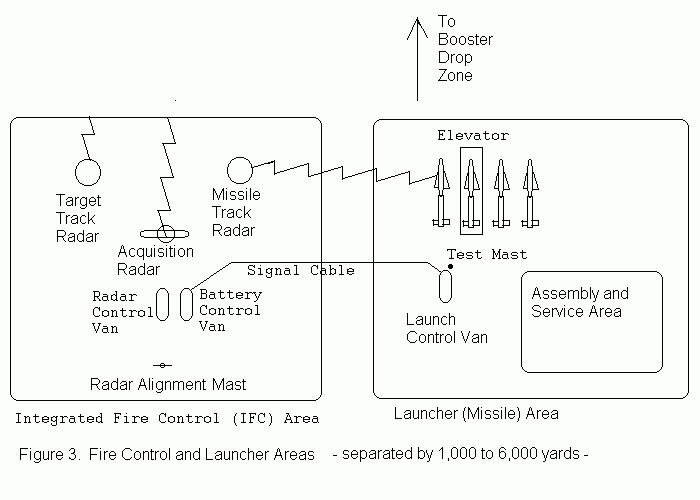
Many launcher areas had
2 "magazines", each with 1 elevator, and 4 launchers. This would permit
8 missiles to be ready to fire at the start of an "engagement". Of course, reloading launchers
from the magazine is expected during an "engagement" :-)) Most Nike
sites in the "lower 48 states" defending cities had elevator magazines such as the above.
Keith Schramm asked
"Why separate radar and launcher areas?".
with
...ifc.html#telephones
The following section is taken directly from pages 2-1 through pages 2-4 of
a U.S. government report
"Historical Overview of the Nike Missile System"
Even before deployment of the Nike Ajax, it was realized that the weapon
system had performance limitations which would prevent it from engaging
formations of high speed, high altitude aircraft which would soon be in use.
Most critical was the limited resolution of the Ajax target tracking radar,
which tended to wander between planes in a formation, resulting in the
missile passing between two aircraft and detonating without causing any
damage to the attackers. In 1952, the Ordnance Corps began feasibility
studies of an improved air defense system which would be capable of
countering anticipated aerial threats and could be modified to keep pace
with advances in attack systems.
Nike Zeus was the first missile developed in the United States that was
designed to defend against intercontinental ballistic missiles (ICBM).
... In 1962, Zeus intercepted a Nike Hercules target. ...
Zeus was never approved for production or deployment as a
tactical system. ... "
The Nike Hercules missile was a more powerful model. It was faster and
had more than three times the range (more than 75 miles)
protecting more than nine times the area with nuclear (as well as conventional) warheads.
The Nike Ajax Acquisition Radar (LOPAR) was retained for added flexibility.
The added Target Ranging Radar (TRR) increased resistance to jamming.
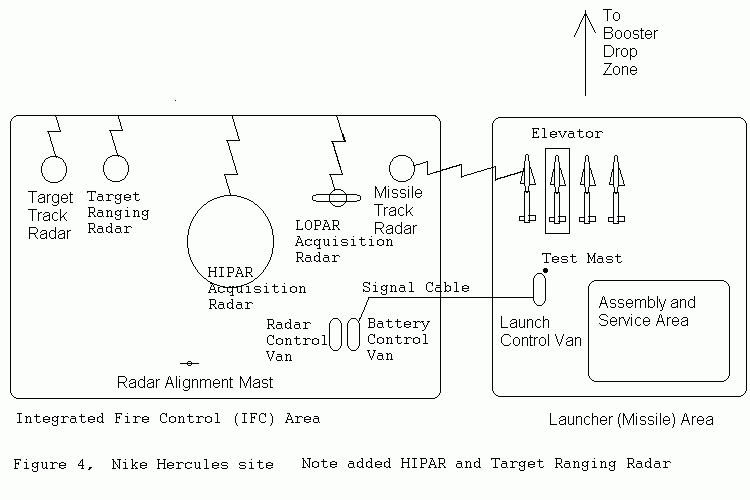
Hercules site D-87,
Union Lake, Michigan, Feb 1973,
sent by Harry Verburg
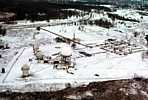
IFC
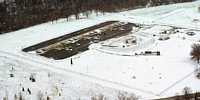
Launcher Area
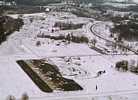
IFC & Launcher area
Does the separation of the MTR and the launcher area look like 1000 yards to you??
Many launcher areas had
2 "magazines", each with 1 elevator, and 4 launchers. This would permit
8 missiles to be ready to fire at the start of an "engagement". Of course, reloading launchers
from the magazine is expected during an "engagement" :-)) Most Nike
sites in the "lower 48 states" defending cities had elevator magazines such as the above.
From Steve Bardowski
This is just an educated guess, but based on my
experience, and travels, ALL sites that were open after 1968
had fallout shelters. I know from personal observation that
all four firing batteries in Chicago in 1972 had them, and the
one site I visited in Detroit [Union Lake] had one. Plus, the
batteries at Munster and Wheeler, which went under the ax in
1971, had them. The battery at Fort Story VA, still open until
the end was so equipped as well. My second guess is that with
the assignment of nukes to all remaining sites, it became a
good idea to protect the troops from their own fallout. The
facilities weren't plush, but roomier than the nuke subs I've
toured while working for the Navy. AND, to this day, Soviet
AFV's have NBC protection from overpressure, which admittedly
does rely on filters. ...
1963 - Peak of Nike Deployment - and the end in 1974
The year was 1963. After years of budgetary problems and continual updates to meet
increasingly sophisticated threats, the Nike Hercules missile defense reached its
peak of deployment and probably efficiency.
Recruiting documents
site selection (102 K Bytes)
and
ARADCOM (133 K Bytes)
glowed with pride and promise.
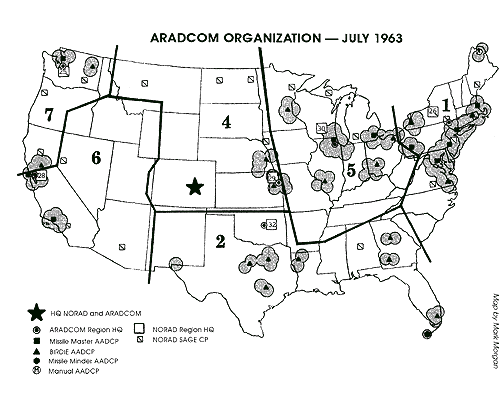
Map credit - "Rings of Supersonic Steel"
A variety of forces caused reduction in Nike from this time forward:
Nike configurations 'world wide'
(This section was added March 2003.)
- Pictures requested.
- Pictures requested.
 of
Site Summit
(from
Billy Sparks)
of
Site Summit
(from
Billy Sparks)
And a  closeup. The view is looking at the front of B-1-43ADA, looking to the east.
closeup. The view is looking at the front of B-1-43ADA, looking to the east.
Nike was 'mobile'?
. . . ["Ha, ha! That's a joke, son!! :-) ] [Like Nike-Herc in Europe being "semi-mobile!
The firing batteries tested THAT concept annually, during their Operation BOOTSTRAP -- with what
one might call "mixed reviews" (the higher up the chain of command, the rosier the viewpoint!!). . . .]
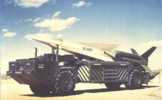
from http://pvo.guns.ru/other/usa/nike-hercules/
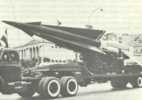
"here is another one i found must be greek. from the site i was on they say they still have active sites there as well as patriot"
Temp sites had their own portable IFCs, radars on trailers, the vans,
etc. I know the Army tested a fully portable Nike Hercules, including one
system that used a missile mounted on this weird eight-well articulated
vehicle (I have the photo somewhere), but to the best of my knowledge ARADCOM
never deployed NH at temp sites. Nike Ajax went in at several temp sites
around the country primarily due to the rush to get the missile up and
operating. MK
I have seen commanders who wanted to think and demonstrate that the Herc system was mobile, but never any that was dumb enough to try to do it with a Nuke. I have witnessed operations where they moved just the Nuke warheads and that is a much bigger deal than moving a whole Hercules System. To move a warhead takes a whole convoy, which must meet some very stringent requirements of vehicle maintenance and conditions. That would be a nightmare to try to go mobile with a Nuke missile.
Owner/Webmaster
http://www.nikeordnance.com/
Was Nike a 'good' system
responding to 'rick' who said "I think even by todays standards this was the best missle system ever developed. We treated them away."
and was very impressed with what I saw about Nike -
Later, the doppler radar HAWK system defended better against low flying aircraft.
However, in my time (1954- early 1957), I, and others, were quite critical of:
I am told that these weak points were almost over corrected by 1960.
I don't know much about the Patriot missile system -
but I think you get:
Never found any reason to criticize Nike hardware,
Fortunately, in that era, I don't think the Soviets had airborne spoof capability
During the later Hercules era, with nuclear weapons, there was lots of physical security
in the launcher areas, and in foreign lands, more security in general.
I wasn't there, and cannot comment.
I worried about this - until I saw that worry was useless -
Anybody with a fire arm or bow & arrow could have stood outside our IFC
chain link fence ( about 70 feet away ) and shot holes through us and/or our equipment.
Although we were told that AT&T employees were "secure", we could easily have been spoofed or cut-off from the outside world.
We were issued a little handi-talki radio,
but were never able to contact anyone with it - The nearest "anyone" would have been more
than 10 miles away.
